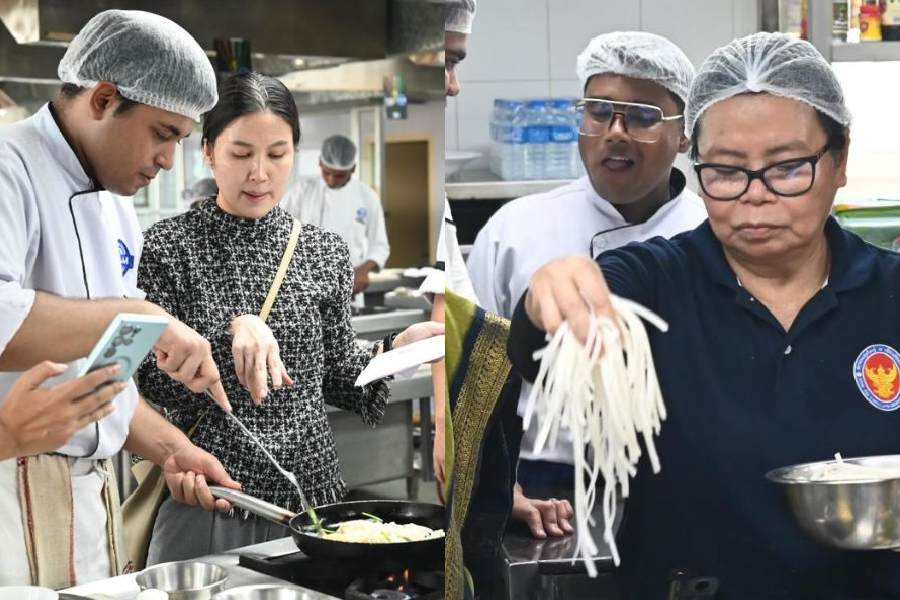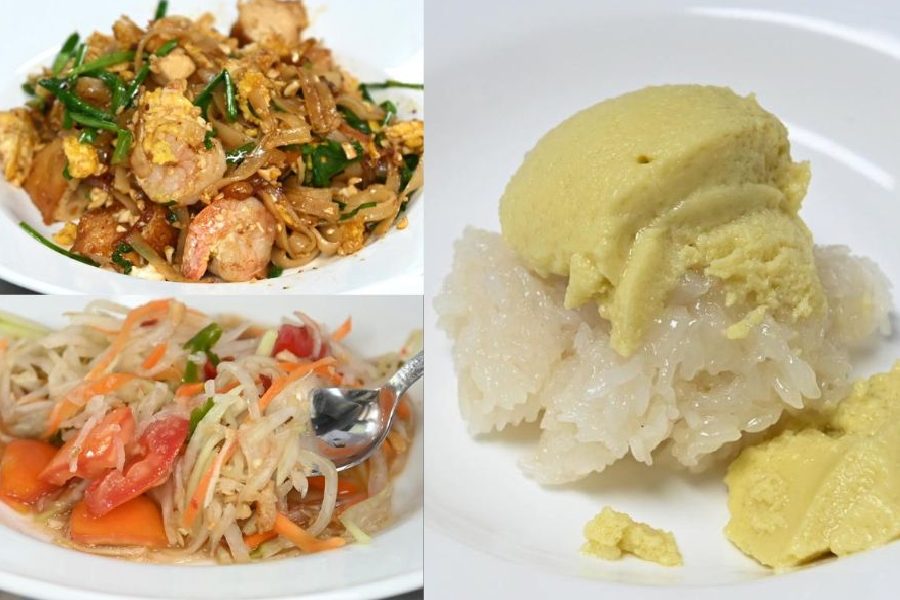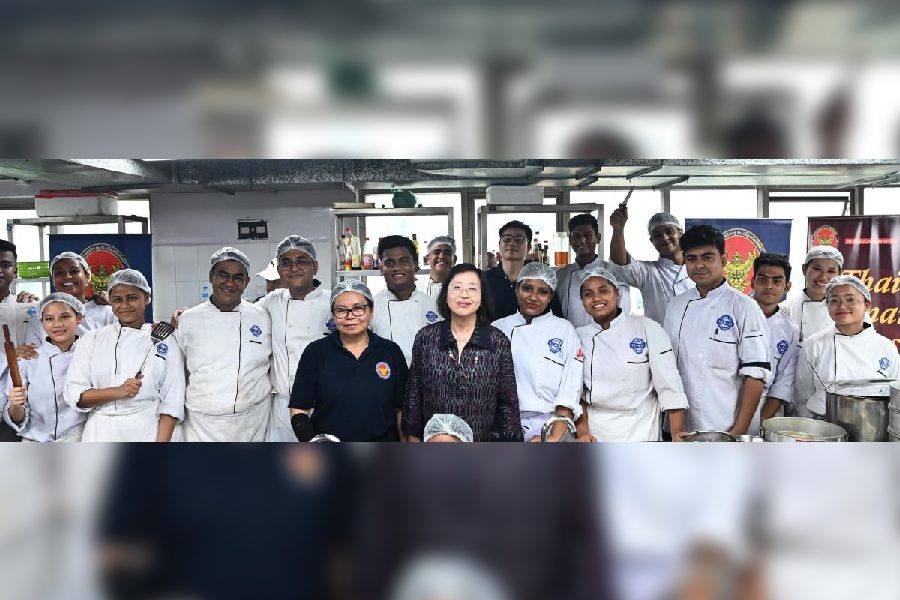A masterclass from the personal chef of the Thai consul general. Access to such culinary authenticity recently was offered to 39 guest participants, comprising chefs from several hotels and restaurants, food bloggers, home cooks, 70 hotel management students and one The Telegraph journalist.
The Thai Culinary Class was being organised over two days by The Royal Thai Consulate-General at the International Institute of Hotel Management (IIHM) campus as an extension of the Amazing Thailand Festival held earlier in the year that had showcased Thailand’s culture and tradition.
“We are focusing on food, one of the five Fs of Thai culture, the others being fashion, films, festival and fight, that is, kickboxing. Thai food is easy to cook. The objective of the event is to familiarise our Indian friends with Thai cuisine, which is loved all over the world. We are sharing the secrets of Thai cuisine in an easy and interactive way. We desire to see more hotels and restaurants in Calcutta serve Thai food and more homes enjoy healthy, delicious, heart-warming Thai cuisine,” said Thai consul general Acharapan Yavaprapas.
On the first day, there was a demonstration exclusively for IIHM students, preceded by a lecture on general information about Thailand, Thai culture, popular tourist destinations, history of Thai cuisine, culinary traditions and the art of Thai cooking given by the consulate-general’s officials. The second day featured two sessions of cook-along for two sets of guests of varying cooking skills, the morning being for restaurant chefs and the afternoon for food bloggers, home cooks and socialites.
Chef Samrong Chanfalueam had chosen six popular Thai savoury and dessert dishes — Glass Noodle Salad (Yam-Wun-Sen), Green Papaya Salad (Som-Tum), Chicken Green Curry (Gang-Khiao-Wan-Gai), Stir-Fried Noodle with Prawn (Pad-Thai-Goong), Mango and Sticky Rice (Khao-Niaow-Ma-Muang), and Thai Custard and Sticky Rice (Khao-Niaow-Sang-Kaya).
For the less-experienced participants of the afternoon session, the three chosen dishes were easy to make with easy-to-find ingredients, which were healthy and nutritious too. The IIHM students, who had attended the introductory class a day earlier, were stationed at each cooking station to help the guests and practise their newly learnt cooking techniques as the two-member teams of participants tried to replicate the recipes shared by the chef.
Before cooking each dish, the participants gathered around the chef and consul Pichaya Lapasthamrong shared instructions in English. It helped that all ingredients were cut and prepared beforehand by the consulate and the participants got pre-portioned ingredients ready at each cooking station.
The participants were very enthusiastic and some of them posed questions that demonstrated their awareness of Thai cuisine, such as the difference between Thai bird’s eye chilli (Prik-Khi-Nu) and the common Indian chilli, how to make green curry paste and Pad Thai sauce from scratch, where to buy Thai Jasmine rice and sticky rice in Calcutta, and the right kind of local mango to serve with sticky rice (Lyangra mango was recommended).
“Our students got great insight from the chef. They got exposed to 10-12 dishes over two days. It is important for them to know what the right ingredients are and what the authentic taste of a dish is like. We as teachers teach them about Thai food but this was a great opportunity to learn from the people of Thailand,” said Mona Das, senior food production faculty, IIHM.
The students cooked and served a four-course Thai luncheon on July 22, based on their learnings from the culinary workshop, earning high praise from the consul general.

(L-R) Consul Napacharapat Kulrakampusiri helps IIHM students; Chef Samrong Chanfalueam demonstrates cooking a dish

(L-R) Consul Pichaya Lapasthamrong issues cooking instructions to IIHM students at the workshop; Consul general Acharapan Yavaprapas at the Thai luncheon at IIHM, Salt Lake
TASTE OF THAILAND

(Top left corner) Pad Thai Gung Sod (Thai Noodle with Prawn)
Ingredients for Noodle: ■ 150g rice stick noodles ■ 5-6 small prawns ■ ½ cup bean sprouts ■ 1 egg ■ 1 tbsp roasted peanuts, crushed ■ ¼ cup garlic chives, chopped into 1-inch length ■ ¼ cup tofu, diced ■ 2-3 cloves garlic, finely chopped ■ 2 tbsp vegetable oil (save some fresh bean sprouts and garlic chives for garnishing)
Ingredients for the sauce: ■ 2 tbsp lemon juice ■ 4 tbsp granulated sugar ■ 2 tbsp tamarind juice ■ 2 tbsp fish sauce ■ ½ tsp grounded dried chillis
Method:
1. To the saucepan, add the granulated sugar, fish sauce, tamarind juice, lemon juice and ground dried chillies. Simmer until the sauce thickens.
2. Soak the noodle in water until soft. Drain the noodle.
3. In a frying pan, heat the oil. Add the chopped garlic. Stir until an aroma develops. Then add tofu and stir for a while.
4. Break the egg into the frying pan and stir thoroughly. Then add the prawn (peeled and deveined), noodles and pour some of the prepared sauce into the pan. Stir until the noodles become dry. Mix all the ingredients together. Pour the remaining sauce into the pan. Then add the bean sprouts, garlic chives and chopped roasted peanuts.
5. Garnish with fresh bean sprouts and garlic chives. Put 1tsp each of crushed peanuts, granulated sugar, and ground dried chillies and one wedge of lime at the side for seasoning.
(Bottom left corner) Som Tam (Green Papaya Salad)
Ingredients: ■ 200g raw green papaya, shredded ■ 2 small garlic cloves, finely chopped ■ 3-5 small chillis, finely chopped ■ ½ cup tomatoes, cut bite-sized ■ ½ cup green beans, ■ chopped into 1-inch length ■ 2 tbsp roasted peanuts ■ 1 tbsp fish sauce ■ 2 tbsp palm sugar ■ 1 ½ tbsp lime juice
Method
1. Peel the skin off the green papaya, half and remove the seeds. Shred finely with a serrated peeler. Chop green bean into 1-inch length. Chop tomato into bite-sized pieces.
2. Add finely chopped garlic and chillies, palm sugar, fish sauce and lime juice in the mixing bowl. Mix well until palm sugar is completely dissolved.
3. Add chopped green beans, chopped tomatoes, and shredded green papaya. Mix with a large spoon.
4. Taste the finished salad, then adjust the flavour with sugar, lime juice, or fish sauce as needed. Mix well with a large spoon and top with peanuts before serving.
*Traditionally, Som Tam is to be made by pestle and mortar. Herbs are lightly pound with the pestle to give a natural and uneven texture, while shredded green papaya is also lightly pounded so that it can absorb the sauce better. However, if you do not have pestle and mortar, you can do simple mixing like ordinary salad instead.
(Right) Khao Niaw Sang Kaya (Thai custard sticky rice)
Ingredients for sweetened sticky rice: ■ 1½ cups glutinous rice ■ 1 cup coconut milk (½ cup) ■ 1⁄3 cup granulated sugar ■ ¼ tsp salt
Ingredients for Thai custard: ■ 250g palm sugar ■ 400g coconut milk (1 can) ■ 3 eggs ■ 5 pieces pandanus leaves ■ ½ tsp salt
Method
1. In a bowl, wash rice well in several changes of cold water until water is clear. Soak rice in cold water to cover overnight. Drain rice well in a sieve or a strainer.
2. Lay cheesecloth over steamer pot and put soaked rice over cheesecloth, then cover the rice with the edge of cheesecloth. Put steamer pot over simmering water, and steam for 30 to 40 minutes, or until tender (check water level in the pot occasionally, adding more water if necessary).
3. While rice is steaming, in a small saucepan bring 1 cup coconut milk to a boil with 1⁄3 cup sugar and salt, stirring until sugar is dissolved, and remove from heat. Keep mixture warm.
4. Transfer cooked rice to a bowl and stir in coconut milk mixture. Let rice rest, covered with cooking wrap for 30 minutes, or until coconut milk mixture is absorbed. Rice may be prepared up to this point 2 hours ahead and kept covered at room temperature.
5. To cook Thai custard, crack eggs into the bowl, add palm sugar, coconut milk, table salt, and pandanus leaves. Mix all the ingredients by hand, especially squeezing pandanus leaves with clump of palm sugar until they dissolve, so the aroma transfers from the leaves to the mixture.
6. Filter the mixture with sieve to remove any clumps. Transfer the mixture to the cake tin. Steam over high heat for about 45 minutes and set aside.
7. To serve, scoop sweetened sticky rice on a plate, followed by custard.
